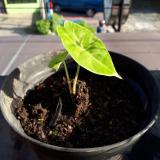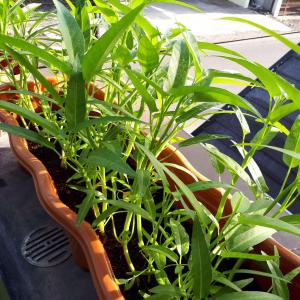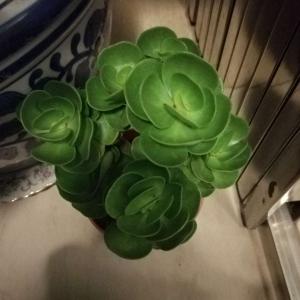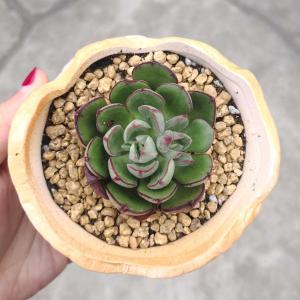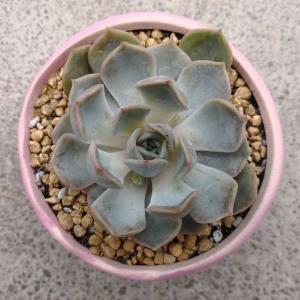文章
权问薇
2018年01月03日


一、季节
1、春
春天是一年中植物生长迅速的时候,春天空气里含的水多,气温也比较低,土壤里的水被较好的锁在里面,所以水分失去的慢,浇水的间隔我们就得拉长一点,大概每周浇一次就可以了。
2、夏
夏天天气炎热,还有可能出现干旱的情况,植物在这个时间特别容易缺水,变得萎靡,这个时候植株种植的盆里面的土壤也会干得快,那么我们就得缩短浇水的间隔,不能像春冬那样隔一星期甚至更久都不浇水,那植物就渴死了。我们基本三四天就得浇一次,帮助植物度过这段考验。

二、室内室外
植物养在室内和室外的浇水方式也都不一样。一般养在室外的浇的时间间隔相对短,室内的相对长。室外的条件下因为空气,风速,湿度等的原因植物失水是要比室内快一些的,风吹日晒的考验肯定比室内安逸舒适要耗去更多的水。

三、土壤
其实植物浇不浇水,浇多少水是一个很没有规律可循的事。不同季节,不同温度,不同湿度,都会影响浇水的量。浇不浇水最直接的判断方法就是看栽的土,如果盆里的土表面发白,有一些缝隙,这说明比较缺水了,该浇了。如果盆里的土比较潮,说明植物还不是那么缺水,至少土里还有较多的水可以提供给植物生长所需。如果这时浇得过多,指不定就会出问题,水多了就根部就会开始变黑变烂。这种判断浇水的方式简单易学,也很管用,不容易出问题。

0
0
文章
权问薇
2018年01月03日


1.选择砍头时间
在对它砍头的时候,一定要选好时间,一般来讲,在春天和秋天的时候最好,因为这个时候是很多多肉植物生长最旺盛的时候,新玉缀也不例外。如果这时候砍头的话,经过砍头的母株会更快速的爆头,同时砍下来的小苗也会更容易发根成活,所以这个时候是最佳的砍头时间。
2.砍头的方法
首先,在砍头之前要先找一个比较适合的位置下手,有些人想着去选择它的顶头位置,可是却不知道,它的植株经过长时间的生长,顶头上的枝干就会较嫩一点,如果砍顶头的话,就不怎么容易生根,还容易脱水,而且还容易感染病菌,让它的伤口没有好之前就软化了。所以不能选择这个位置。应该找一些稍微硬化的位置,然后把它砍下来就可以了。注意砍的时候,一定要给母株留下一点叶片,这样可以让它很快长出来新的叶子。

3.砍头后的养护
对于砍下来的新玉缀,千万不能让它的伤口碰到水了,尤其是不能受到雨淋,不然就会容易让它感染病菌的,而且还不能让它直射太阳,要适当的减少光照,就可以有利于它顺利长出小苗。我们可以把砍下来的新玉缀,放在没有强光并且通风好的地方一星期,等到它的伤口完全干了并且已经收缩了再去种,然后种完之后,也不能急着让它晒太阳,应该多等个2到3星期,这时候它的根基本上都已经固定了,也就是已经成活了,然后就可以像母株一样进行正常的养护就可以了。

1
0
文章
权问薇
2018年01月03日

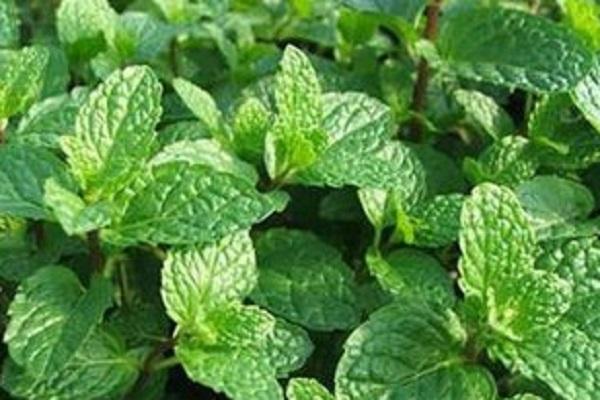
一、关于种植步骤:
1.选择繁殖类型:苹果薄荷可以分为扦插繁殖和种子播种。因为种子繁殖的苹果薄荷不仅生长速度缓慢,而且还容易变异随着死亡,所以一般来说,我们都是采用的扦插繁殖苹果薄荷。
2.选择繁殖时间:用扦插繁殖苹果薄荷,我们可以选择春季或冬季。春季种植一般在三月下旬,冬季种植一般在十月下旬。
3.种子保存:因为太高的温度容易使苹果薄荷的种子缺水导致死亡,所以在夏季高温时,我们应将种子置于阴凉处来进行保存。
4.松土:播种前,选择排水性好的疏松土壤,在播种苹果薄荷前要将土壤浇透。
5.撒种:我们在播撒种子时,要注意均匀散布。因为苹果薄荷的种子很小,因此无需覆盖土层。
6.喷水:在播种后,我们可用喷壶对种子进行喷水保湿,使土壤的湿度保持适宜
7.保温:在播种初期,我们可以选择用保鲜膜进行过覆盖保温,待苹果薄荷的种子发芽后,我们就可以摘除保鲜膜了。
二、.关于注意事项:
1.土壤选择:我们土壤选择疏松肥沃、排水较好的砂质土。
2.定植:等到苹果薄荷种子长出五到六片叶子后,我们就可以选择定植了。我们应该先把小苹果薄荷苗扶正,整理理顺它的根,紧接着,我们需要填上土并压实,最后,一次浇透土壤。
3.追肥:待小苹果薄荷苗生长一段时间后,我们可以选择追施适量的肥。
4.水分调节:要在苹果薄荷幼苗的不断生长过程中要进行不断的调节。在生长初期,苹果薄荷幼苗需要的水分较多,在开花期间,苹果薄荷幼苗需要水分就比较少。
5阳光:苹果薄荷幼苗需要充分的光照。如果光照不足,苹果薄荷幼苗容易徒长。

0
1
文章
Miss Chen
2018年01月03日

Description: This herbaceous perennial plant is about ½–1½' tall, often branching abundantly and presenting a bushy appearance. The weak stems are ascending to sprawling; they are light green, sharply 4-angled, shallowly furrowed along their sides, and mostly glabrous, except where the whorled leaves occur. Near the bases of these leaves, there are narrow rings of dense short hairs on the stems. At intervals along these stems, there are whorls of 4-6 sessile leaves. Where the lower stems branch dichotomously, there are usually whorls of 5-6 leaves, otherwise there are whorls of 4 leaves. Relative to their stems, these leaves are ascending to widely spreading. Individual leaves are ½–1¼" long and about one-fourth as much across; they are elliptic-oblong to oblong in shape, while their margins are entire (toothless) and stiffly ciliate. The upper and lower leaf surfaces are medium green and mostly glabrous. However, the lower leaf surfaces are stiffly short-hairy along their central veins. These hairs can cling for support on adjacent plants.
The upper and outer stems terminate in dichotomously branched clusters of 2-4 flowers; there are 1-2 small clusters of 2-4 flowers per stem. The glabrous peduncles of these floral clusters are up to 1" long and the glabrous pedicels of the flowers are up to ½" long. Each flower is a little less than ¼" across, consisting of a white corolla with 4 lanceolate lobes, a pair of pistils, and 4 stamens; the calyx is minute and insignificant. The inferior ovaries of the pistils are light green, and glabrous; together they are biglobular in shape. The blooming period occurs from late spring to mid-summer, lasting about 1 month. Usually only a few flowers are in bloom at the same time. After the blooming period, the ovaries mature into a pair of joined dry fruits; each fruit contains a single seed. The seeds are about 0.5 mm. long, somewhat flattened, and globoid. The root system is fibrous.
Cultivation: The preference is full sun to light shade, wet to moist conditions, and soil containing organic matter. This plant doesn't like to dry out, and it slowly fades away after blooming.

Range & Habitat: The native Wild Madder is an occasional to locally common plant that has been reported from most counties of Illinois. However, it is uncommon or absent in some central and western counties of the state (see Distribution Map). Habitats include wet to moist black soil prairies, prairie swales, floodplain woodlands, soggy thickets, swamps, fens, seeps, and shallow ditches along railroads. This plant tends to occur in grassy or sedge-dominated areas and it functions as an understory plant in wet to moist prairies. However, with the destruction of such prairie habitat, it has become less common than in the past.
Faunal Associations: Generally, the small white flowers of Wild Madder (Galium obtusum) and other bedstraws (Galium spp.) attract small bees and flies, including Halictid bees, masked bees (Hylaeus spp.), and Syrphid flies. These insects cross-pollinate the flowers. Some insects feed destructively on the foliage and other parts of bedstraws. These species include flower-feeding larvae of the Bedstraw Midge (Dasineura americana), foliage-feeding larvae of an introduced sawfly (Halidamia affinis), and the larvae of such moths as the Galium Sphinx (Hyles gallii), Drab Brown Wave (Lobocleta ossularia), and White-banded Toothed Carpet (Epirrhoe alternata). Bedstraws are also summer hosts of the polyphagous Black Cherry Aphid (Myzus cerasi). Little is known about the floral-faunal relationships of Wild Madder with vertebrate animals.

Photographic Location: The photographs were taken at a moist prairie remnant along an abandoned railroad in Champaign County, Illinois.
Comments: Except for the showy Northern Bedstraw (Galium boreale), bedstraws (Galium spp.) are often overlooked by prairie restorationists and wildflower enthusiasts because of their small flowers. Wild Madder can be distinguished from other bedstraws by the following characteristics: 1) it has smooth hairless stems, 2) there are usually only 4 leaves per whorl, although sometimes 5-6 leaves per whorl, 3) the fruits are smooth and hairless, 4) the flowers have 4 corolla lobes, and 5) the leaves are blunt-tipped. Other bedstraws often have bristly stems and fruits, more than 4 leaves per whorl, flowers with 3 corolla lobes, and/or leaves with more pointed tips. Another common name of Galium obtusum is Blunt-leaved Bedstraw.
The upper and outer stems terminate in dichotomously branched clusters of 2-4 flowers; there are 1-2 small clusters of 2-4 flowers per stem. The glabrous peduncles of these floral clusters are up to 1" long and the glabrous pedicels of the flowers are up to ½" long. Each flower is a little less than ¼" across, consisting of a white corolla with 4 lanceolate lobes, a pair of pistils, and 4 stamens; the calyx is minute and insignificant. The inferior ovaries of the pistils are light green, and glabrous; together they are biglobular in shape. The blooming period occurs from late spring to mid-summer, lasting about 1 month. Usually only a few flowers are in bloom at the same time. After the blooming period, the ovaries mature into a pair of joined dry fruits; each fruit contains a single seed. The seeds are about 0.5 mm. long, somewhat flattened, and globoid. The root system is fibrous.
Cultivation: The preference is full sun to light shade, wet to moist conditions, and soil containing organic matter. This plant doesn't like to dry out, and it slowly fades away after blooming.

Range & Habitat: The native Wild Madder is an occasional to locally common plant that has been reported from most counties of Illinois. However, it is uncommon or absent in some central and western counties of the state (see Distribution Map). Habitats include wet to moist black soil prairies, prairie swales, floodplain woodlands, soggy thickets, swamps, fens, seeps, and shallow ditches along railroads. This plant tends to occur in grassy or sedge-dominated areas and it functions as an understory plant in wet to moist prairies. However, with the destruction of such prairie habitat, it has become less common than in the past.
Faunal Associations: Generally, the small white flowers of Wild Madder (Galium obtusum) and other bedstraws (Galium spp.) attract small bees and flies, including Halictid bees, masked bees (Hylaeus spp.), and Syrphid flies. These insects cross-pollinate the flowers. Some insects feed destructively on the foliage and other parts of bedstraws. These species include flower-feeding larvae of the Bedstraw Midge (Dasineura americana), foliage-feeding larvae of an introduced sawfly (Halidamia affinis), and the larvae of such moths as the Galium Sphinx (Hyles gallii), Drab Brown Wave (Lobocleta ossularia), and White-banded Toothed Carpet (Epirrhoe alternata). Bedstraws are also summer hosts of the polyphagous Black Cherry Aphid (Myzus cerasi). Little is known about the floral-faunal relationships of Wild Madder with vertebrate animals.

Photographic Location: The photographs were taken at a moist prairie remnant along an abandoned railroad in Champaign County, Illinois.
Comments: Except for the showy Northern Bedstraw (Galium boreale), bedstraws (Galium spp.) are often overlooked by prairie restorationists and wildflower enthusiasts because of their small flowers. Wild Madder can be distinguished from other bedstraws by the following characteristics: 1) it has smooth hairless stems, 2) there are usually only 4 leaves per whorl, although sometimes 5-6 leaves per whorl, 3) the fruits are smooth and hairless, 4) the flowers have 4 corolla lobes, and 5) the leaves are blunt-tipped. Other bedstraws often have bristly stems and fruits, more than 4 leaves per whorl, flowers with 3 corolla lobes, and/or leaves with more pointed tips. Another common name of Galium obtusum is Blunt-leaved Bedstraw.
0
0
文章
Miss Chen
2018年01月03日

Description: This wildflower is a summer annual about 1½–3' tall that is either unbranched or very sparingly branched. The central stem is erect, stout, terete, and covered with fuzzy hairs that are white, gray, or brown. Opposite leaves occur along the lower one-third of the stem. The leaves are up to 4" long and ¾" across. They are narrowly elliptic to elliptic or narrowly oblanceolate to oblanceolate in shape; their margins are smooth. At the base, the leaves are sessile or they have short petioles; their outer tips are blunt. The upper leaf surface is medium green, white along the margins, and sparsely covered with silky hairs. The lower leaf surface is pale green and more densely covered with silky hairs. The central stem is slightly swollen and reddish at the bases of the opposite leaves. The central stem terminates in a spike of flowers about 1½–4" long and there are usually 1-3 lateral spikes of flowers that are either sessile or on short peduncles. These lateral spikes are usually shorter in length than the terminal spike.
The terminal spike and its peduncle often lean to one side toward the apex of the plant. Each spike is densely packed with white woolly flowers that are arranged in 5 spirals (if the spike is long enough to determine this). Individual flowers are initially conical in shape, but they soon swell to become shaped like a short vase with a short narrow neck. The exterior of the flower is dominated by a white woolly calyx that is about 4-6 mm. long and across at maturity. The calyx has 5 tiny teeth at its apex that are cream-colored or pink. Inserted within the apex of the calyx are 5 stamens and a style; there are no petals. The filaments of the stamens are joined together to form an inner tubular structure that contains the ovary (or seed capsule). The blooming period occurs from mid-summer to early fall and lasts 2-3 months. Each flower matures into a single-seeded cottony fruit that often develops a pair of crests along its lower sides. A crest consists of a succession of dentate teeth. The cottony fruits are blown about by the wind. The seeds are 1.0–1.5 mm. long, ovoid, somewhat flattened, and brown. The root system consists of a taproot. This wildflower reproduces by reseeding itself.

Cultivation: The preference is full sun, dry conditions, and sandy soil with sparse ground vegetation. Gravelly soil is also tolerated.
Range & Habitat: The Large Cottonweed is occasional in sandy areas of NE Illinois and the western half of the state, where it is native; elsewhere, this plant is uncommon or absent (see Distribution Map). Habitats consist of sandy hill prairies, dry sand prairies, sand dunes, sunny open areas in sandy savannas, sandy fields, areas along sandy paths, and sandy or gravelly areas along railroads. To some extent, Large Cottonweed has extended its range along railroads. Disturbed areas are preferred. Occasional wildfires are probably beneficial in reducing the encroachment of herbaceous perennials and woody vegetation.

Faunal Associations: Information about floral-faunal relationships for this species is sparse. The flowers are probably wind-pollinated or self-fertile, rather than insect-pollinated. The thrips, Haplothrips malifloris, feeds on the leaves of Large Cottonweed and similar species. It is possible that the toothed fruits can cling to the fur of mammals or the feathers of birds, but this has not been well-documented. If it is true, such animal-mediated dispersal would help to spread the seeds into new areas.
Photographic Location: A sunny area near a sandy path at the Hooper Branch Savanna Nature Preserve in Iroquois County, Illinois.

Comments: This strange-looking wildflower immediately catches one's attention when it is encountered while in bloom or in fruit. The floral spikes are exceptionally white and cottony. The only other species in this genus that can be found in Illinois is Froelichia gracilis (Slender Cottonweed), which is probably adventive from the region of the Southern Plains. It is similar in appearance to Large Cottonweed, but less showy. Slender Cottonweed differs from Large Cottonweed by its shorter height (less than 2' tall), more slender leaves (less than ½" across), and shorter floral spikes (1½" or less). It also tends to branch more at the base, producing sprawling stems. Species in this genus are also referred to by the somewhat ominous name, 'Snakecotton.' Thus, Froelichia floridana is sometimes referred to as 'Plains Snakecotton.'
The terminal spike and its peduncle often lean to one side toward the apex of the plant. Each spike is densely packed with white woolly flowers that are arranged in 5 spirals (if the spike is long enough to determine this). Individual flowers are initially conical in shape, but they soon swell to become shaped like a short vase with a short narrow neck. The exterior of the flower is dominated by a white woolly calyx that is about 4-6 mm. long and across at maturity. The calyx has 5 tiny teeth at its apex that are cream-colored or pink. Inserted within the apex of the calyx are 5 stamens and a style; there are no petals. The filaments of the stamens are joined together to form an inner tubular structure that contains the ovary (or seed capsule). The blooming period occurs from mid-summer to early fall and lasts 2-3 months. Each flower matures into a single-seeded cottony fruit that often develops a pair of crests along its lower sides. A crest consists of a succession of dentate teeth. The cottony fruits are blown about by the wind. The seeds are 1.0–1.5 mm. long, ovoid, somewhat flattened, and brown. The root system consists of a taproot. This wildflower reproduces by reseeding itself.

Cultivation: The preference is full sun, dry conditions, and sandy soil with sparse ground vegetation. Gravelly soil is also tolerated.
Range & Habitat: The Large Cottonweed is occasional in sandy areas of NE Illinois and the western half of the state, where it is native; elsewhere, this plant is uncommon or absent (see Distribution Map). Habitats consist of sandy hill prairies, dry sand prairies, sand dunes, sunny open areas in sandy savannas, sandy fields, areas along sandy paths, and sandy or gravelly areas along railroads. To some extent, Large Cottonweed has extended its range along railroads. Disturbed areas are preferred. Occasional wildfires are probably beneficial in reducing the encroachment of herbaceous perennials and woody vegetation.

Faunal Associations: Information about floral-faunal relationships for this species is sparse. The flowers are probably wind-pollinated or self-fertile, rather than insect-pollinated. The thrips, Haplothrips malifloris, feeds on the leaves of Large Cottonweed and similar species. It is possible that the toothed fruits can cling to the fur of mammals or the feathers of birds, but this has not been well-documented. If it is true, such animal-mediated dispersal would help to spread the seeds into new areas.
Photographic Location: A sunny area near a sandy path at the Hooper Branch Savanna Nature Preserve in Iroquois County, Illinois.

Comments: This strange-looking wildflower immediately catches one's attention when it is encountered while in bloom or in fruit. The floral spikes are exceptionally white and cottony. The only other species in this genus that can be found in Illinois is Froelichia gracilis (Slender Cottonweed), which is probably adventive from the region of the Southern Plains. It is similar in appearance to Large Cottonweed, but less showy. Slender Cottonweed differs from Large Cottonweed by its shorter height (less than 2' tall), more slender leaves (less than ½" across), and shorter floral spikes (1½" or less). It also tends to branch more at the base, producing sprawling stems. Species in this genus are also referred to by the somewhat ominous name, 'Snakecotton.' Thus, Froelichia floridana is sometimes referred to as 'Plains Snakecotton.'
0
0
文章
Miss Chen
2018年01月03日

Description: This herbaceous perennial plant is 4-7" tall, consisting of several basal leaves and one or more inflorescences. The basal leaves are trifoliate. The leaflets are up to 2½" long and 1½" across; they are obovate or oval in shape and coarsely toothed along their middle to outer margins. The tips of leaflets are rounded, while their bottoms are either wedge-shaped or rounded. The upper leaflet surface is medium to dark green and glabrous. The lower leaflet surface is variably hairy; fine hairs are most likely to occur along the bases of central veins, but they may occur elsewhere along the lower surface. Leaflet venation is pinnate and conspicuous. The petiolules (basal stalklets) of leaflets are light green, hairy, and very short (about 1 mm. in length). The petioles of basal leaves are up to 6" long; they are light green to light reddish green, terete, and hairy. One or more umbel-like clusters of flowers are produced from long peduncles up to 5" long. These peduncles are light green to light reddish green, terete, and hairy. Each umbel-like cluster has about 4-6 flowers on pedicels up to ¾" long. These pedicels are light green to light reddish green, terete, and hairy. At the base of these pedicels, there are several bracts up to ¼" long that are light green to dark red, lanceolate in shape, and hairy.
Individual flowers are about ½–¾" across when they are fully open; they can be pistillate, staminate, or perfect (staminate flowers are the least common). Each flower has 5 white petals, 5 green sepals, and 5 green sepal-like bracts. The petals are oval to orbicular in shape; they are longer than either the sepals or sepal-like bracts. The sepals are lanceolate in shape and hairy, while the sepal-like bracts are linear-lanceolate and hairy; both sepals and sepal-like bracts are joined together at the base of the flower. Each pistillate flower has a dome-shaped cluster of pistils at its center that is greenish yellow or pale yellow. Each staminate flower has 20-35 stamens with pale yellow filaments and yellow anthers. Each perfect flower has a dome-shaped cluster of pistils at its center and a ring of surrounding stamens. The blooming period occurs from late spring to early summer, lasting about 3-4 weeks. Afterwards, the flowers are replaced by fruits when growing conditions are favorable, otherwise they abort. These fruits are up to ½" long and across; they are globoid or globoid-ovoid in shape, becoming bright red at maturity. Small seeds are scattered across the surface of these fruits in sunken pits; the persistent sepals and sepal-like bracts are appressed to the upper surface of these fruits. The fleshy interior of these fruits has a sweet-tart flavor; they are edible. The root system consists of a shallow crown with fibrous roots. After the production of flowers and fruits, hairy above-ground stolons up to 2' long may develop from the crown. When the tips of these stolons touch the ground, they often form plantlets that take root. In this manner, clonal colonies of plants often develop.

Cultivation: The preference is full or partial sun, moist to dry-mesic conditions, and fertile soil containing loam or clay-loam. Wild Strawberry is a cool-season plant that grows actively during the spring and fall, but it often becomes dormant after setting fruit during the hot summer months. This plant is easy to cultivate, and it will spread to form a loose ground cover in open areas. The foliage is more resistant to foliar disease than most cultivated strawberries. While flowers are produced reliably every spring where there is adequate sunlight, the fruits may or may not develop, depending on the weather and environmental conditions. Watering plants during dry spells in late spring and early summer probably encourages fruits to develop. These fruits are much smaller in size than those of cultivated strawberries.
Range & Habitat: The native Wild Strawberry is common in most areas of Illinois, although in parts of NW and southern Illinois it is occasional or absent (see Distribution Map). Habitats include black soil prairies, hill prairies, bluegrass meadows, small meadows in wooded areas, open woodlands, woodland borders, savannas, limestone glades, roadsides, and areas along railroads. Wild Strawberry is able to tolerate competition from taller plants because it develops early in the spring, and it is able to tolerate some shade later in the year. This plant occurs in both degraded and high quality habitats, often not far from wooded areas.

Faunal Associations: The ecological value of Wild Strawberry to various insects, birds, and animals is high. The nectar and pollen of the flowers attract little carpenter bees (Ceratina spp.), cuckoo bees (Nomada spp.), mason bees (Osmia spp.), Halictid bees (including green metallic bees), Halictid cuckoo bees (Sphecodes spp.), Andrenid bees, Syrphid flies, thick-headed flies (Conopidae), Tachinid flies, bottle flies (Lucilia spp.), flesh flies (Sarcophagidae), small butterflies, and skippers (see Robertson, 1929, & others). These floral visitors are beneficial because they cross-pollinate the flowers. Other insects feed destructively on the foliage and other parts of Wild Strawberry. Caterpillars of the Grizzled Skipper (Pyrgus centaurae wyandot) feed on this plant. Other insect feeders include larvae of such moths as the Strawberry Crown Borer (Synanthedon bibionipennis), Strawberry Leafroller Moth (Ancylis comptana fragariae), and Wild Strawberry Seed Borer (Grapholita angleseana). The Moth Table has a more complete list of moth species that feed on this plant.

Other insect feeders include the Strawberry Flea Beetle (Altica ignita) and other leaf beetles (Chrysomelidae), the Strawberry Sap Beetle (Stelidota gemmata), the Strawberry Root Weevil (Otiorhynchus ovatus) and other weevils (Curculionidae), larvae of the Strawberry Reniform Gall Midge (Cecidomyia reniformis), larvae of the Strawberry Cylindrical Gall Wasp (Diastrophus fragariae), larvae of the Curled Rose Sawfly (Allantus cinctus) and other sawflies, the Strawberry Aphid (Chaetosiphon fragaefolii) and other aphids, and flower thrips. The Insect Table has a more complete list of insect species that feed on this plant. Various vertebrate animals eat the fruits and foliage of Wild Strawberry. Many upland gamebirds and songbirds eat the fruits, including the Ring-necked Pheasant, Greater Prairie Chicken, Brown Thrasher, Eastern Towhee, and American Robin. Some mammals, including the Opossum, Eastern Skunk, Franklin Ground Squirrel, Eastern Chipmunk, and White-footed Mouse, also eat the fruits, as do the Eastern Box Turtle, Ornate Box Turtle, and Wood Turtle. By eating the fruits, these animals spread the seeds to new locations. The foliage of Wild Strawberry is a source of food for the Cottontail Rabbit, White-tailed Deer, Groundhog, and Meadow Vole. The foliage is also browsed by horses, cattle, sheep, and goats. The Wildlife Table has a more complete list of vertebrate animals that feed on this plant.

Photographic Location: The photographs were taken along a roadside near Urbana, Illinois; at Dave Monk's postage stamp prairie in Champaign, Illinois; and at the wildflower garden of the webmaster in Urbana, Illinois.
Comments: This is one of the parent plants for the cultivated strawberry (Fragaria × ananassa). The other parent plant of the cultivated strawberry is the Coastal Strawberry (Fragaria chiloensis). This latter species is found along the Pacific Coast in both North and South America. The cultivated strawberry inherited the superior flavor of the Wild Strawberry (Fragaria virginiana) and the larger fruit size of the Coastal Strawberry. The Wild Strawberry produces attractive white flowers during the spring and small red fruits during the early summer. It is similar in appearance to another native species, the Hillside Strawberry (Fragaria vesca americana). The fruits of Hillside Strawberry have sepals and sepal-like bracts that are spreading to reflexed, rather than appressed. The fruits of Hillside Strawberry also have seeds scattered on top of their surfaces, rather than enclosed in shallow pits. This strawberry species is found in northern Illinois, where it is uncommon. It is closely related to the Alpine Strawberry (Fragaria vesca vesca), which is found in Europe.
Individual flowers are about ½–¾" across when they are fully open; they can be pistillate, staminate, or perfect (staminate flowers are the least common). Each flower has 5 white petals, 5 green sepals, and 5 green sepal-like bracts. The petals are oval to orbicular in shape; they are longer than either the sepals or sepal-like bracts. The sepals are lanceolate in shape and hairy, while the sepal-like bracts are linear-lanceolate and hairy; both sepals and sepal-like bracts are joined together at the base of the flower. Each pistillate flower has a dome-shaped cluster of pistils at its center that is greenish yellow or pale yellow. Each staminate flower has 20-35 stamens with pale yellow filaments and yellow anthers. Each perfect flower has a dome-shaped cluster of pistils at its center and a ring of surrounding stamens. The blooming period occurs from late spring to early summer, lasting about 3-4 weeks. Afterwards, the flowers are replaced by fruits when growing conditions are favorable, otherwise they abort. These fruits are up to ½" long and across; they are globoid or globoid-ovoid in shape, becoming bright red at maturity. Small seeds are scattered across the surface of these fruits in sunken pits; the persistent sepals and sepal-like bracts are appressed to the upper surface of these fruits. The fleshy interior of these fruits has a sweet-tart flavor; they are edible. The root system consists of a shallow crown with fibrous roots. After the production of flowers and fruits, hairy above-ground stolons up to 2' long may develop from the crown. When the tips of these stolons touch the ground, they often form plantlets that take root. In this manner, clonal colonies of plants often develop.

Cultivation: The preference is full or partial sun, moist to dry-mesic conditions, and fertile soil containing loam or clay-loam. Wild Strawberry is a cool-season plant that grows actively during the spring and fall, but it often becomes dormant after setting fruit during the hot summer months. This plant is easy to cultivate, and it will spread to form a loose ground cover in open areas. The foliage is more resistant to foliar disease than most cultivated strawberries. While flowers are produced reliably every spring where there is adequate sunlight, the fruits may or may not develop, depending on the weather and environmental conditions. Watering plants during dry spells in late spring and early summer probably encourages fruits to develop. These fruits are much smaller in size than those of cultivated strawberries.
Range & Habitat: The native Wild Strawberry is common in most areas of Illinois, although in parts of NW and southern Illinois it is occasional or absent (see Distribution Map). Habitats include black soil prairies, hill prairies, bluegrass meadows, small meadows in wooded areas, open woodlands, woodland borders, savannas, limestone glades, roadsides, and areas along railroads. Wild Strawberry is able to tolerate competition from taller plants because it develops early in the spring, and it is able to tolerate some shade later in the year. This plant occurs in both degraded and high quality habitats, often not far from wooded areas.

Faunal Associations: The ecological value of Wild Strawberry to various insects, birds, and animals is high. The nectar and pollen of the flowers attract little carpenter bees (Ceratina spp.), cuckoo bees (Nomada spp.), mason bees (Osmia spp.), Halictid bees (including green metallic bees), Halictid cuckoo bees (Sphecodes spp.), Andrenid bees, Syrphid flies, thick-headed flies (Conopidae), Tachinid flies, bottle flies (Lucilia spp.), flesh flies (Sarcophagidae), small butterflies, and skippers (see Robertson, 1929, & others). These floral visitors are beneficial because they cross-pollinate the flowers. Other insects feed destructively on the foliage and other parts of Wild Strawberry. Caterpillars of the Grizzled Skipper (Pyrgus centaurae wyandot) feed on this plant. Other insect feeders include larvae of such moths as the Strawberry Crown Borer (Synanthedon bibionipennis), Strawberry Leafroller Moth (Ancylis comptana fragariae), and Wild Strawberry Seed Borer (Grapholita angleseana). The Moth Table has a more complete list of moth species that feed on this plant.

Other insect feeders include the Strawberry Flea Beetle (Altica ignita) and other leaf beetles (Chrysomelidae), the Strawberry Sap Beetle (Stelidota gemmata), the Strawberry Root Weevil (Otiorhynchus ovatus) and other weevils (Curculionidae), larvae of the Strawberry Reniform Gall Midge (Cecidomyia reniformis), larvae of the Strawberry Cylindrical Gall Wasp (Diastrophus fragariae), larvae of the Curled Rose Sawfly (Allantus cinctus) and other sawflies, the Strawberry Aphid (Chaetosiphon fragaefolii) and other aphids, and flower thrips. The Insect Table has a more complete list of insect species that feed on this plant. Various vertebrate animals eat the fruits and foliage of Wild Strawberry. Many upland gamebirds and songbirds eat the fruits, including the Ring-necked Pheasant, Greater Prairie Chicken, Brown Thrasher, Eastern Towhee, and American Robin. Some mammals, including the Opossum, Eastern Skunk, Franklin Ground Squirrel, Eastern Chipmunk, and White-footed Mouse, also eat the fruits, as do the Eastern Box Turtle, Ornate Box Turtle, and Wood Turtle. By eating the fruits, these animals spread the seeds to new locations. The foliage of Wild Strawberry is a source of food for the Cottontail Rabbit, White-tailed Deer, Groundhog, and Meadow Vole. The foliage is also browsed by horses, cattle, sheep, and goats. The Wildlife Table has a more complete list of vertebrate animals that feed on this plant.

Photographic Location: The photographs were taken along a roadside near Urbana, Illinois; at Dave Monk's postage stamp prairie in Champaign, Illinois; and at the wildflower garden of the webmaster in Urbana, Illinois.
Comments: This is one of the parent plants for the cultivated strawberry (Fragaria × ananassa). The other parent plant of the cultivated strawberry is the Coastal Strawberry (Fragaria chiloensis). This latter species is found along the Pacific Coast in both North and South America. The cultivated strawberry inherited the superior flavor of the Wild Strawberry (Fragaria virginiana) and the larger fruit size of the Coastal Strawberry. The Wild Strawberry produces attractive white flowers during the spring and small red fruits during the early summer. It is similar in appearance to another native species, the Hillside Strawberry (Fragaria vesca americana). The fruits of Hillside Strawberry have sepals and sepal-like bracts that are spreading to reflexed, rather than appressed. The fruits of Hillside Strawberry also have seeds scattered on top of their surfaces, rather than enclosed in shallow pits. This strawberry species is found in northern Illinois, where it is uncommon. It is closely related to the Alpine Strawberry (Fragaria vesca vesca), which is found in Europe.
0
0
文章
Miss Chen
2018年01月03日

Description: This perennial herbaceous plant is 1½–3½' tall, branching frequently in the upper half to create a bushy appearance. The slender stems are light green, glabrous, and terete (circular in cross-section). Along the entire length of these stems, there are abundant alternate leaves that become gradually smaller in size as they ascend. These leaves are 1½–4" long and 1.5–4 mm. (less than ¼") across; they are linear in shape, entire (toothless) along their margins, medium green, glabrous (hairless), and either sessile or short-petiolate. The leaves have prominent central veins, and some of the wider leaves have pairs of lateral veins that are also visible. The upper stems terminate in clusters of flowerheads that together form a collective inflorescence that is somewhat flat-headed or dome-shaped and irregular. Within this inflorescence, clusters of 3-7 flowerheads often occur that are sessile during the bud stage, although some of them develop short pedicels while they are in bloom. The branches of these floral clusters are similar to the stems, except they are more angular and occasionally short-hairy. Small leafy bracts up to 1" long occur where these branches divide; these bracts are linear in shape.
A mature flowerhead is about 3 mm. (1/8") across while in bloom, consisting of 10-12 ray florets and 4-7 disk florets. The petaloid rays of the flowerheads are short-oblong in shape, bright yellow, and ascending to widely spreading. The corollas of the disk florets are cylindrical in shape, 5-lobed, and bright yellow. At the base of each mature flowerhead, small phyllaries (floral bracts) occur in several overlapping series that are appressed together to form an involucre (a cup-shaped structure at the base of the flowerhead). For a mature flowerhead, this involucre is 4-6 mm. long and cylindrical in shape, tapering at its base. Individual phyllaries are elliptic-oblong in shape, light green to pale yellow, glabrous, and oily in appearance. The blooming period occurs from late summer to autumn, lasting about 1-2 months for a colony of plants. In the collective inflorescence of each plant, the flowerheads bloom gradually over a period of time, rather than all at once. Afterwards, the florets are replaced by achenes with small tufts of white hair; they are dispersed by the wind. These achenes are about 1 mm. long, bullet-shaped, and finely pubescent. The root system is fibrous and long-rhizomatous, often forming clonal colonies of plants.

Cultivation: The preference is full sun, moist to dry conditions, and sandy soil, although this plant readily adapts to other kinds of soil containing loam, clay, silt, or gravel. Cool rainy weather or excessive overhead watering can make the lower leaves vulnerable to rust. During an extended drought, some of the lower leaves may wither away, which is normal. Overall, this little-known plant is easy to cultivate in gardens – perhaps too easy, as it is able to spread aggressively by means of its long rhizomes in the average garden situation.
Range & Habitat: Plains Grass-leaved Goldenrod occurs occasionally throughout Illinois, but it is more common in the northern and western areas of the state (see Distribution Map). This plant is native to the state. The distribution map is from Jones & Fuller (1955), rather than the ILPIN database, because of some inaccuracies in the latter. Habitats include black soil prairies, sand prairies, gravel prairies, railroad prairies, meadows along rivers, rocky glades, roadsides, areas along railroads, and sandy fields. Plains Grass-leaved Goldenrod is more typical of areas to the west in the Great Plains, but it is still locally common in some parts of the state.

Faunal Associations: The nectar and pollen of the flowerheads attract an abundance of bees, wasps, flies, small butterflies, skippers, moths, beetles, plant bugs, and stink bugs. A plasterer bee, Colletes simulans armata, and such Andrenid bees as Andrena hirticincta, Andrena nubecula, and Andrena simplex, are specialist pollinators (oligoleges) of goldenrods, including Euthamia spp. The Goldenrod Soldier Beetle (Chauliognathus pennsylvanicus), in particular, is a common visitor of the flowerheads. Other insects feed on the foliage and other parts of Plains Grass-leaved Goldenrod. These species include a leaf beetle, Exema byersi, and such grasshoppers as the Western Grass-green Grasshopper (Hesperotettix speciosus), Meadow Purple-striped Grasshopper (Hesperotettix viridis), Keeler's Grasshopper (Melanoplus keeleri luridus), and Scudder's Short-winged Grasshopper (Melanoplus scudderi latus); see Clark et al. (2004) and Campbell et al. (1974). It is not uncommon to find various insects hiding within the dense leafy stems and clustered flowerheads during the day, including moths, caterpillars, and predatory insects; Ambush Bugs (Phymata spp.) are particularly common. The foliage of goldenrods is eaten occasionally by mammalian herbivores, particularly when it is young and more tender.
Photographic Location: The photographs were taken of plants growing in the webmaster's garden in Urbana, Illinois.

Comments: Different authorities don't agree on the distribution of Plains Grass-leaved Goldenrod (Euthamia gymnospermoides) within Illinois. For example, Mohenbrock (2002) and the ILPIN database restrict the distribution of this species to the northern and western areas of the state, while Jones & Fuller (1955) and A.G. Jones (1973) state that this species occurs in other areas of the state. In my experience, these latter authorities are correct, as I have encountered Plains Grass-leaved Goldenrod in some railroad prairies of east-central Illinois. It is easy to confuse this species with the more common Grass-leaved Goldenrod (Euthamia graminifolia). Plains Grass-leaved Goldenrod differs by having less than 20 florets per flowerhead (including both disk & ray florets), hairless stems, slightly more narrow leaves, and a more bushy appearance from densely branched stems. Grass-leaved Goldenrod, in contrast, has more than 20 florets per flowerhead, stems with lines of hair, slightly wider leaves, and a less branched appearance. Another species, Lake Grass-leaved Goldenrod (Euthamia remota), differs from Plains Grass-leaved Goldenrod by having slightly more slender leaves and shorter involucres (3-4 mm. long) on its mature flowerheads. Lake Grass-leaved Goldenrod probably should be reclassified as a disjunct population of Coastal Grass-leaved Goldenrod (Euthamia caroliniana); see efloras for more information.
A mature flowerhead is about 3 mm. (1/8") across while in bloom, consisting of 10-12 ray florets and 4-7 disk florets. The petaloid rays of the flowerheads are short-oblong in shape, bright yellow, and ascending to widely spreading. The corollas of the disk florets are cylindrical in shape, 5-lobed, and bright yellow. At the base of each mature flowerhead, small phyllaries (floral bracts) occur in several overlapping series that are appressed together to form an involucre (a cup-shaped structure at the base of the flowerhead). For a mature flowerhead, this involucre is 4-6 mm. long and cylindrical in shape, tapering at its base. Individual phyllaries are elliptic-oblong in shape, light green to pale yellow, glabrous, and oily in appearance. The blooming period occurs from late summer to autumn, lasting about 1-2 months for a colony of plants. In the collective inflorescence of each plant, the flowerheads bloom gradually over a period of time, rather than all at once. Afterwards, the florets are replaced by achenes with small tufts of white hair; they are dispersed by the wind. These achenes are about 1 mm. long, bullet-shaped, and finely pubescent. The root system is fibrous and long-rhizomatous, often forming clonal colonies of plants.

Cultivation: The preference is full sun, moist to dry conditions, and sandy soil, although this plant readily adapts to other kinds of soil containing loam, clay, silt, or gravel. Cool rainy weather or excessive overhead watering can make the lower leaves vulnerable to rust. During an extended drought, some of the lower leaves may wither away, which is normal. Overall, this little-known plant is easy to cultivate in gardens – perhaps too easy, as it is able to spread aggressively by means of its long rhizomes in the average garden situation.
Range & Habitat: Plains Grass-leaved Goldenrod occurs occasionally throughout Illinois, but it is more common in the northern and western areas of the state (see Distribution Map). This plant is native to the state. The distribution map is from Jones & Fuller (1955), rather than the ILPIN database, because of some inaccuracies in the latter. Habitats include black soil prairies, sand prairies, gravel prairies, railroad prairies, meadows along rivers, rocky glades, roadsides, areas along railroads, and sandy fields. Plains Grass-leaved Goldenrod is more typical of areas to the west in the Great Plains, but it is still locally common in some parts of the state.

Faunal Associations: The nectar and pollen of the flowerheads attract an abundance of bees, wasps, flies, small butterflies, skippers, moths, beetles, plant bugs, and stink bugs. A plasterer bee, Colletes simulans armata, and such Andrenid bees as Andrena hirticincta, Andrena nubecula, and Andrena simplex, are specialist pollinators (oligoleges) of goldenrods, including Euthamia spp. The Goldenrod Soldier Beetle (Chauliognathus pennsylvanicus), in particular, is a common visitor of the flowerheads. Other insects feed on the foliage and other parts of Plains Grass-leaved Goldenrod. These species include a leaf beetle, Exema byersi, and such grasshoppers as the Western Grass-green Grasshopper (Hesperotettix speciosus), Meadow Purple-striped Grasshopper (Hesperotettix viridis), Keeler's Grasshopper (Melanoplus keeleri luridus), and Scudder's Short-winged Grasshopper (Melanoplus scudderi latus); see Clark et al. (2004) and Campbell et al. (1974). It is not uncommon to find various insects hiding within the dense leafy stems and clustered flowerheads during the day, including moths, caterpillars, and predatory insects; Ambush Bugs (Phymata spp.) are particularly common. The foliage of goldenrods is eaten occasionally by mammalian herbivores, particularly when it is young and more tender.
Photographic Location: The photographs were taken of plants growing in the webmaster's garden in Urbana, Illinois.

Comments: Different authorities don't agree on the distribution of Plains Grass-leaved Goldenrod (Euthamia gymnospermoides) within Illinois. For example, Mohenbrock (2002) and the ILPIN database restrict the distribution of this species to the northern and western areas of the state, while Jones & Fuller (1955) and A.G. Jones (1973) state that this species occurs in other areas of the state. In my experience, these latter authorities are correct, as I have encountered Plains Grass-leaved Goldenrod in some railroad prairies of east-central Illinois. It is easy to confuse this species with the more common Grass-leaved Goldenrod (Euthamia graminifolia). Plains Grass-leaved Goldenrod differs by having less than 20 florets per flowerhead (including both disk & ray florets), hairless stems, slightly more narrow leaves, and a more bushy appearance from densely branched stems. Grass-leaved Goldenrod, in contrast, has more than 20 florets per flowerhead, stems with lines of hair, slightly wider leaves, and a less branched appearance. Another species, Lake Grass-leaved Goldenrod (Euthamia remota), differs from Plains Grass-leaved Goldenrod by having slightly more slender leaves and shorter involucres (3-4 mm. long) on its mature flowerheads. Lake Grass-leaved Goldenrod probably should be reclassified as a disjunct population of Coastal Grass-leaved Goldenrod (Euthamia caroliniana); see efloras for more information.
0
0


